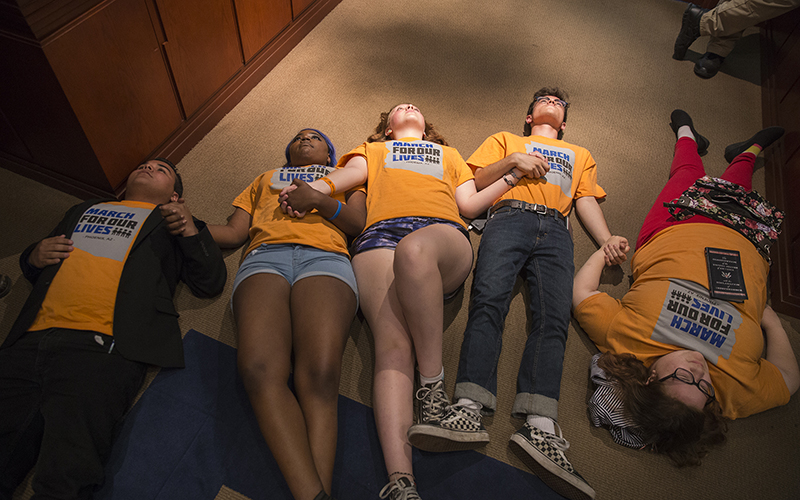WASHINGTON – When a 14-year-old fatally shot himself in a Coronado K-8 Elementary School bathroom on Jan. 9, the incident was announced by the Sierra Vista Unified School District and the Cochise County Sheriff’s Department.
But it did not show up in any larger school system database.
Had it occurred two years earlier, the shooting would have been recorded in a U.S. Department of Education database on firearm incidents in schools. But the department’s Office for Civil Rights stopped collecting such reports after the 2015-16 school year.
The office gave no reason for its decision when it announced it would no longer collect “firearms incidents” reports, and repeated calls to the office for comment were not returned.
The lack of a standard database has left advocates scrambling at a time when specific and organized data on firearms is “critical to understanding how, when, and why these incidents occur.”
“I think the reason there is so much debate about how often school shootings occur is because we don’t have a federal source that is providing updated and accurate information with an agreed-upon definition,” said Kelly Drane, a public health research associate for Giffords, the gun-safety coalition.
“It’s not just collecting the right data, it’s creating a definition that we can use and all refer to so we are on the same page and can improve from there,” Drane said.
Students across the country walked out of their classes on Friday, the 19th anniversary of the shooting at Columbine High School that killed 13. The organizer of the walkout, Connecticut student Lane Murdock, 16, said in an online petition site that gathered more than a quarter-million signatures that the event was a response to recent shootings.
“The violence of guns is being performed in our schools and our communities. Not the Senate floor,” Murdock wrote in the online petition.
But while shootings like Columbine are still rare enough to garner headlines, the definition of school shooting varies depending on who’s collecting the information.
Those looking for information on school shootings must turn to nonprofit research and advocacy groups like Everytown and Giffords, or online think tanks that track events based off news reports. But their definitions differ, leading to differing statistics on school shootings.
By Everytown standards, a January 2018 incident in Denison, Texas, where a student discharged a firearm and shot through a wall – but harmed no one – was labeled a school shooting, the same as the fatal self-inflicted shooting at the school in Sierra Vista.
Everytown defines a school shooting as “any time a firearm discharges a live round inside a school building or on a school campus or grounds,” regardless of whether there are injuries or deaths reported, such as in the Coronado incident.
There was a time when the state collected the information.
The Arizona Department of Education created the AZSafe database in 2008 to better track incidents involving and relating to school violence, such as firearms and drug use. The Arizona Safe and Drug Free Schools Report produced data on how often firearms were brought to schools and how often they were fired on campus.
After AZSafe lost federal grant funding in 2011, it was taken over by the U.S. Department of Education’s Office of Civil Rights, according to state schools spokesman Stefan Swiat. But while the state mandated reporting, it became voluntary when the federal government took over, Swiat said.
With no mandated reporting, reports were inconsistent. That was a missed opportunity for the federal government, said Rep. Tom O’Halleran, D-Sedona.
“Part of the problem is that if states do it alone, then we report within the state and not nationally,” O’Halleran said. “If we don’t fund it nationally, then we have an incongruent system where some states will report more rigorously and some won’t, and because of that we won’t have a full picture of what is really occurring.”
But now not even that data is available since the OCR stopped collecting the data two years ago, along with 20 other reports on subjects ranging from mathematics participation scores to discipline incidents to staff evaluations.
The Gun Violence Archive and Giffords Law Center, national nonprofits that track firearm violence across the country, collect information regarding gun violence but do not currently have data measuring firearm incidents at schools per state. That means that incidents like those at Coronado do not appear.
Both Everytown and Giffords have data on the number mass shootings per state, many of which do occur on campus.
According the Gun Violence Archive website, a mass shooting is defined as a shooting involving four or more victims that are injured or killed. The archive reports that in 2018, there have been 51 mass shootings across the country.
Lauren Cutilletta, legal director for the Giffords Law Center, said the center gave Arizona an “F” rating in its most recent gun-law scorecard because “the state has the 47th-weakest gun laws in the country and the 16th-highest gun death rate compared to other states.”
While the Education Department is no longer collecting school firearms data, Drane noted that Congress recently clarified budget language from 1996 that was thought to ban research into gun violence by the Centers for Disease Control and Prevention. In the latest budget bill, passed in the wake of the shooting at Parkland, Florida, the CDC was cleared to fund research into gun violence.
But Drane said there is still more to be done.
“There are other agencies doing some gun violence research, like the National Institute of Health and other agencies like the Department of Justice, but they aren’t on the level that we need for an issue of this magnitude,” she said. “We need really good research that can show us what the cause is, who is perpetrating it and how we can combat it.”

